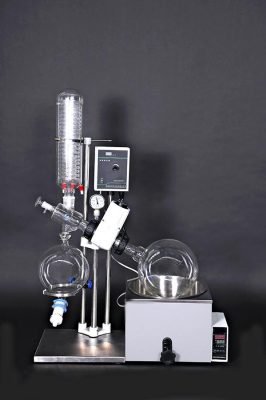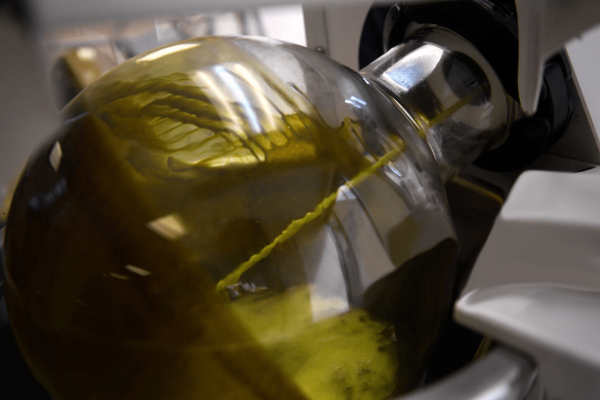Description
Rotary evaporators are mainly used to evaporate light boiling components under normal pressure or vacuum. When used in pilot plant and small scale production they are also suitable for semi-continuous evaporation. They are characterized by providing a gentle thermal treatment for temperature-sensitive mediums and provide a higher evaporation rate as non-stirred glass distillation flasks. Compared to other evaporation processes the unique process feature of rotary evaporators is their ability to evaporate all volatile media providing at the end a dry product in the flask.
The liquid to be processed in the rotary evaporator is either charged batch wise by gravity, by a pump or sucked-in by vacuum into the evaporation flask. During the evaporation process further feed can be added by means of a pump, gravity or by the operating vacuum through the PTFE-hose passing the rotating shaft and ending in the spherical vessel. The rotating sphere is half way rotating through the liquid in a heating bath filled with water or another suitable liquid heating fluid. The bath is heated by means of electrical heating elements and can be lowered to immediately stop the evaporation process.
The rotation of the sphere which is flanged to the geared motor ensures an effective mixing of the product inside the vessel and wets the complete inner surface of the sphere, increasing the evaporation surface, therefore increasing the evaporation rate and hence shortening the evaporation time.
The components with the lower boiling point are evaporated in the rotating sphere first. Their vapours flow through a sleeve shaft integrated in the drive and enter the condenser assembly. The vapours are condensed and optionally cooled in an distillate cooler before being captured in a final distillate receiver.


Rotary Evaporator consists of :
- Heating Bath with lifting
- Rotating spherical flask Drive
- Condensation section
- Control panel
- Twin Receiver Flasks
- Mechanical PTFE-seal for slight overpressure or low vacuum
Application
- Solvent evaporation
- Crystallization
- Drying of suspensions, powders or granulates
- Various chemical reactions in the liquid phase
Rotary Evaporator features
- Robust construction and sealing
- Easy transportation of flasks via flask handling trolley
- Digital display of process parameters
- Control of parameters through control panel
- Mounted on castor wheels for easy movement
- Proper observability of the processes
| Equipment description | Rotation flask 20 L | Rotation flask 30L | Rotation flask 50L | Rotation flask 100L |
|---|---|---|---|---|
| Model | RE-20LG | RE-30G | RE-50G | RE-100G |
| Bath Lift | Motorized | |||
| Dimension | 1110W*650D*2150H | 1515W*650D*2200H | 1940W*900D*2900H | 2050W*900D*2970H |
| Condensate Area | 0.6 m2 | 1 m2 | 1.5 m2 | 2.5 m2 |
| Rotation Speed | 0 ~120 rpm | 0~120 rpm | 12~120 rpm | 12~120 rpm |
| Receiving flask | 10 L | 20 L | 20 L | 30 L |
| RPM indicator | Digital :20~90 (Water bath)/Digital : 20 ~200 ( Oil bath) | |||
| Vacuum (Ultimate Pressure) | 133 Pa (1 torr) | |||
| Heater | 4 KW | 6 KW | ||
| Temp. Control | PID from main heater, ON/OFF control | |||
RELATED CONTENT
This product belongs to the solution

